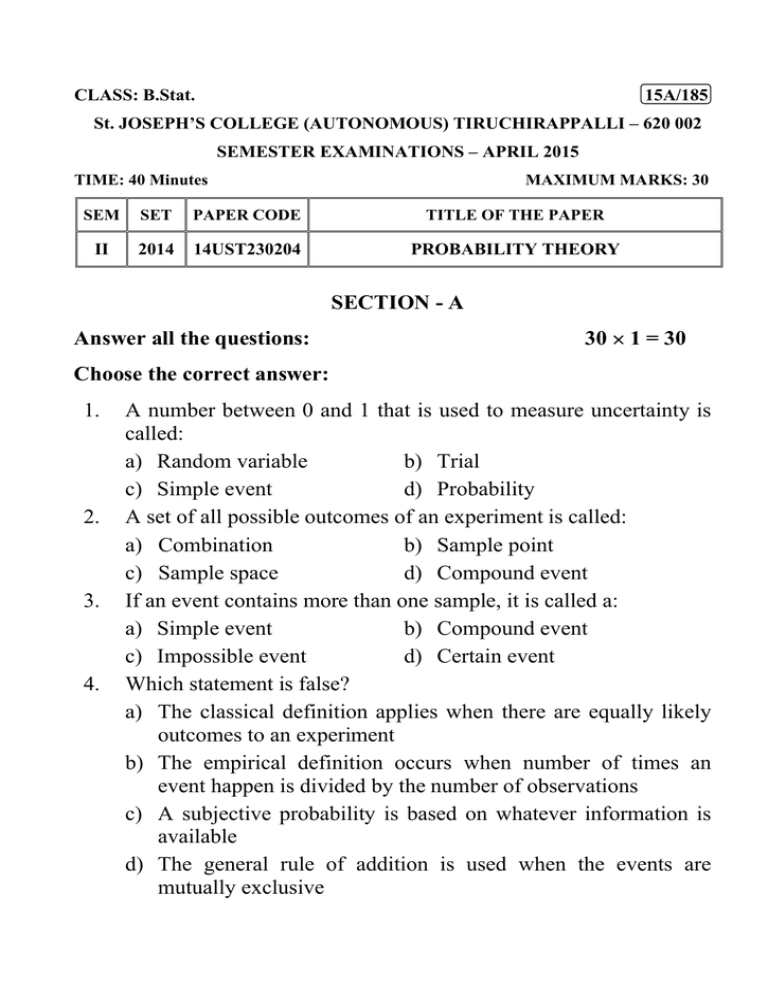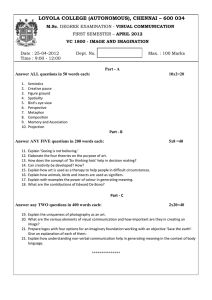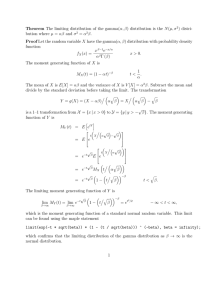SECTION - A Answer all the questions: 30 × 1 = 30 Choose the
advertisement

CLASS: B.Stat.
15A/185
St. JOSEPH’S COLLEGE (AUTONOMOUS) TIRUCHIRAPPALLI – 620 002
SEMESTER EXAMINATIONS – APRIL 2015
TIME: 40 Minutes
MAXIMUM MARKS: 30
SEM
SET
PAPER CODE
TITLE OF THE PAPER
II
2014
14UST230204
PROBABILITY THEORY
SECTION - A
Answer all the questions:
30 ¥ 1 = 30
Choose the correct answer:
1.
2.
3.
4.
A number between 0 and 1 that is used to measure uncertainty is
called:
a) Random variable
b) Trial
c) Simple event
d) Probability
A set of all possible outcomes of an experiment is called:
a) Combination
b) Sample point
c) Sample space
d) Compound event
If an event contains more than one sample, it is called a:
a) Simple event
b) Compound event
c) Impossible event
d) Certain event
Which statement is false?
a) The classical definition applies when there are equally likely
outcomes to an experiment
b) The empirical definition occurs when number of times an
event happen is divided by the number of observations
c) A subjective probability is based on whatever information is
available
d) The general rule of addition is used when the events are
mutually exclusive
5.
6.
7.
8.
9.
The six faces of die are called equally likely if the die is:
a) Small
b) Fair
c) Six-faced
d) Round
If A is an empty set and B is a non-empty set then:
b) A « B = B
a) A « B = S
c) A » B = B
d) P(A) = p(B)
The conditional probability of the event A when event B has
occurred is denoted by:
a) P(A+B)
b) P(A-B)
c) P(A/B)
d) P(A)
If A is an arbitrary event, then P(A/A) is equal to:
a) Zero
b) One
c) Infinity
d) Less than one
If A and B are any two events, then P(A « B)
a) 1 - P(A » B)
b) 1 - P(A « B)
c) 1 - P(A « B)
d) 1 - P(A « B)
10. Two coins are tossed. The probability that both faces will be
matching is given by:
a) ¼
b) ½
c) 1
d) Zero
11. Two dice are rolled. Probability of getting the total less than 4 or
total more than 10 is given by:
b) 4/36
a) 10/36
d) 14/36
c) 1/36
12. If A and B are mutually exclusive events, them.
a) P(A » B) = P(A) - P(B) b) P(A » B) = P(A) + P(B)
c) P(A » B) = 0
d) None of these
13. For two random variables X and Y, the relation E(XY) =
E(X)E(Y), holds good
a) If X and Yare statistically independent
b) For all X and Y
c) If X and Y are identical
d) None of these
14. If Var(X) = 1, then Var(2X±3) is
a) 5
b) 13
c) 4
d) 0
15. If C is a constant (non-random variable), then E(C) is:
a) 0
b) 1
c) cf(c)
d) C
16. A list of all the outcomes of an experiment and the probability
associated with each outcome is called:
a) Probability distribution
b) Probability density function
c) Attributes
d) Distribution function
17. The probability function of a random variable is defined as:
x
-1
-2
0
1
2
f(x)
K
2k
3k
4k
5k
Then k is equal to:
a) Zero
b) ¼
c) 1/15
d) One
18. Total area under the curve of a continuous probability density
function is always equal to:
a) Zero
b) One
c) -1
d) None of these
19. The function that generates moments
a) Moment generating function
b) Characteristics function
c) Both a and b
d) Cumulant generating function
20. The function that exists always
a) Moment generating function
b) Characteristics function
c) Both a and b
d) Cumulant generating function
21. If X is a random variable and f(x) be the probability function, then
subject to the convergence, the function, Âetxf(x) is known as:
a) Moment generating function
b) Probability generating function
c) Probability distribution function
d) Characteristic function
22. The characteristic function of the sum of a number of independent
random variables is equal to
a) The product of the characteristic functions
b) The sum of the respective characteristic function
c) Logarithm of the sum of the respective characteristic function
d) None of these
23. Identify the false statement
a) Mean = k1
c) m3 = k3
b) m1 = k 2 = var iance
d) m = k + 3k 2
4
4
2
24. According to Uniqueness theorem of moment generating function:
a) The moment generating function of a distribution, if it exists,
uniquely determines the distribution
b) The moment generating function of a distribution, uniquely
determines the distribution
c) The moment generating function of a distribution, if it exists,
uniquely determines the moments
d) None of these
25. If X is a continuous random variable with mean m and variance
s 2 , then for any positive number k, P{1X - m1 ≥ ks} £ 1/ k 2 is
known as:
a) Lyapunov’s inequality
b) Chebycher’s inequality
c) Bienayme-Chebychev’s inequality d) Khintchine’s-inequality
26. According to Chebychev’s inequality, the probability that:
a) X differing from its mean by more than 2 standard deviations
is less than or equal to 0.75
b) X will lie within 2 standard deviations of its mean, is greater
than or equal to 0.75
c) X will lie with 2 standard deviations of its means, is greater
than or equal to 0.25
d) X will lie with 2 standard deviations of its means, is greater
than or e
27. A sequence of random variables X1, X2 ,......Xn is said to converge
in probability to a constant a, if for any Œ> 0
a) P{X n - a <Œ} = 1
b) P{X n - a ≥Œ} = 0
d) P{X n - a <Œ} = 0
c) Both a and b
28. Let X1, X2,……Xn be the sequence of random variable and
m1, m 2,........ m n be their respective expectation and let
Bn = Var (X1 + X2 + .......Xn ) < a then
P{(X1 + X 2 + ...... + X n ) / n - (m1 + m 2 + ......m n ) / n <Œ} = h for
all n>n0, where Πand h are arbitrary small positive numbers,
(
)
provided lim Bn / n 2 tends to 0 is known as
n Æa
a)
b)
c)
d)
Weak law of large numbers
Strong law of large numbers
Bernoulli’s law of large numbers
None of these
29. Let X1, X2……Xn be the sequence of random variable and
m1, m 2,....... m n be
their respective expectation and let
Bn = Var (X1 + X2 + ......Xn ) < • . According to weak law of
large numbers
P{X1 + X 2 + ...... + X n / n - (m1 + m2 + ......mn / n <Œ} ≥ h , for all
n>n0, where Πand h, are arbitrary small positive numbers,
provided
b) lim Bn / n 2 tends to 1
a) lim Bn / n 2 tends to 0
c)
(
)
n Æa
lim (Bn / n 2 ) tends to -1
n Æa
(
n Æa
)
d) None of these
30. If Xi = 1, with probability p and 0, with probability q then the
distribution of the random variable Sn = X1 + X2 +…….Xn, where
Xi’s are independent is asymptotically normal as n tends to • is
known as
a) De-Moivre’s laplace theorem
b) Lindeberg-Levy theorem
c) Liapounoff’s central limit theorem
d) Cramer’s theorem
*********************





